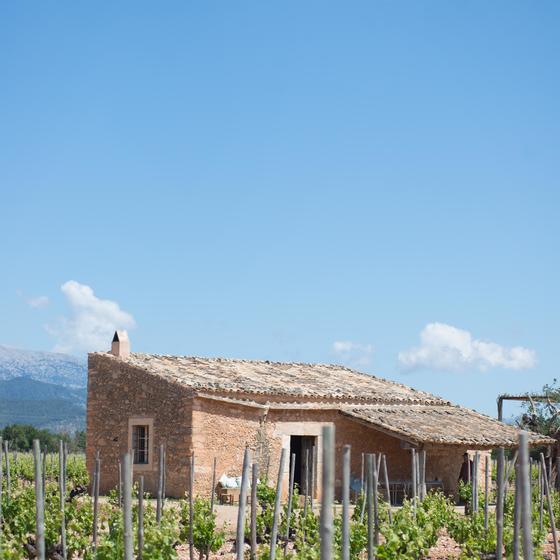An ancient farming village in Portugal’s Alentejo region dispenses calm and bounty to modern-day seekers.
29 March, 2021
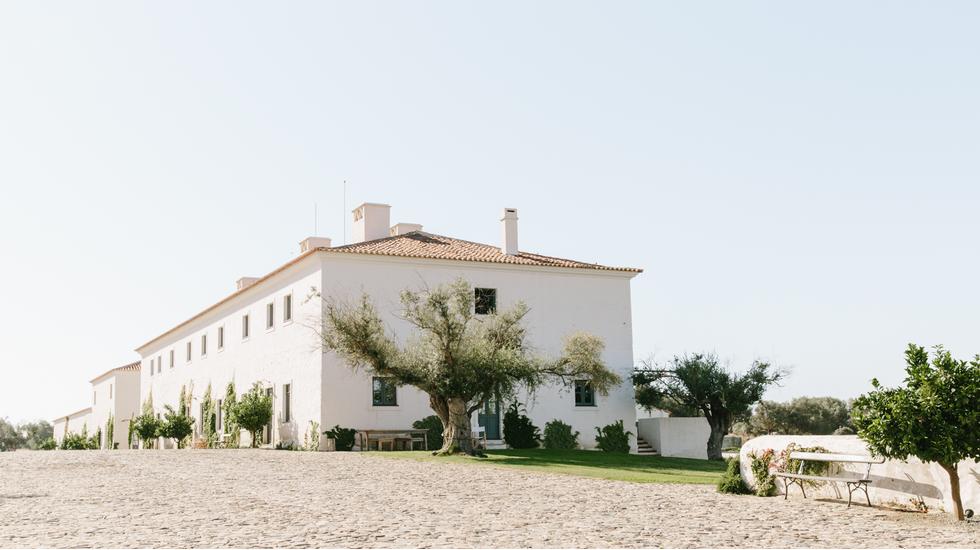
The article first appears in Vol. 24: Slow.
Through
the windscreen I catch sight of the whitewashed village
of Monsaraz, its castle gloatingly balanced at its apex. A discreet
signpost signals our departure from the main highway. Drawn away
from the mystical town that now rests just beyond our view, we zip
along a byroad until our wheels are slowed by cattle grids.
Surrounded by barrocais – huge outcrops of rock dotting the
landscape – the entry to the São Lourenço do Barrocal estate is deliciously
unkempt. The grounds are skirted with twisted, truncated olive
trees spanning some 60 hectares, which bow and feign in the
direction of the main estate as our car continues up a narrowing
path to the central monte (farming buildings).
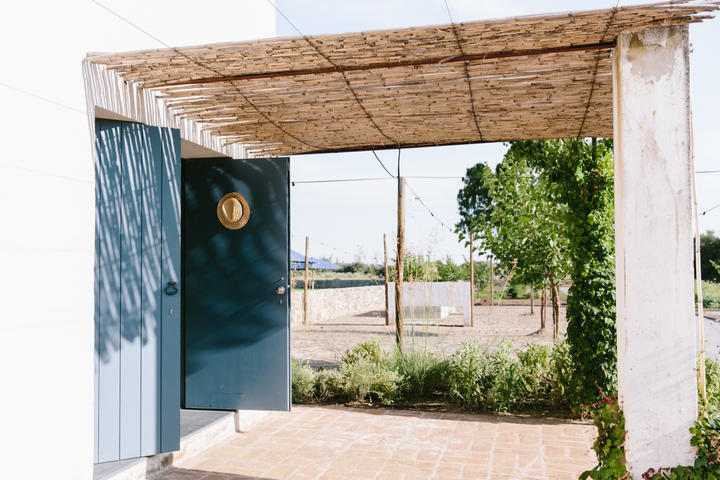
A former agrarian community, today São Lourenço do Barrocal is a
working winery, olive grove and hotel. Opening in late 2015, the
low-lying farmhouse hideaway is the work of former investment
banker José António Uva. Returning from London determined to
reinvigorate his family monte – taken away when Portugal was
nationalised and returned in disrepair following the country’s
liberalisation – José spent two years at the estate living in the
outhouse adjacent to the pool and dreaming up plans for its
development. As the eighth generation of the same family to have
lived at São Lourenço do Barrocal, José readily recalls a childhood
suffused with endless tales of its 1940s heyday. From then until
now, he tells me, “everything and nothing has changed”.
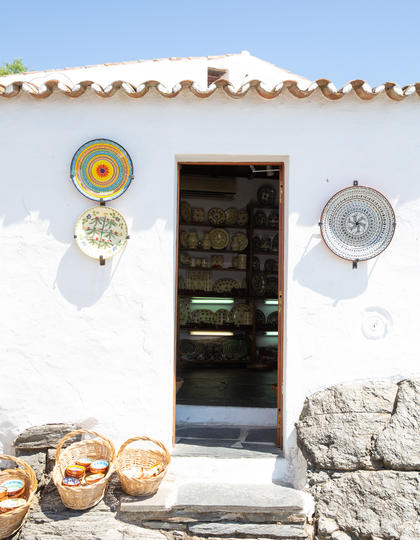
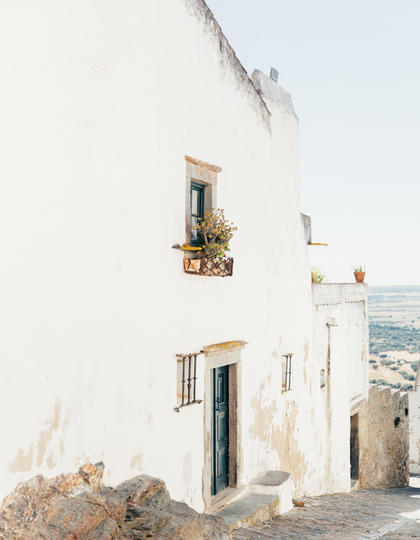
In the lobby old photographs suggest a life of social gatherings
– beach holidays, al-fresco dining, jubilant birthdays and drawn-
out weddings. Tin boxes of letters are crammed like Tetris blocks
and mounted on the walls. José explains to me that trying to
understand what served for which purpose was an arduous task in the
early stages of restoration. “Letters, legal documents and receipts
all had to be sifted through before deciding what should be kept
and what could be transformed.”
Over an eight-year period José collaborated with award-winning
architect Eduardo Souto de Moura on the estate. Together with a
biologist, an historian and a geologist, a sense of the strata of
the place was slowly established. “It was about adjusting rather
than changing the space,” José says. Imposing small-scale
interventions, José committed to living off the land. Time paved
out 14 years of renovations, José’s family grew by three and the
roof tiles alone took as many years to gather (over half a million
baked original brick tiles were used.)
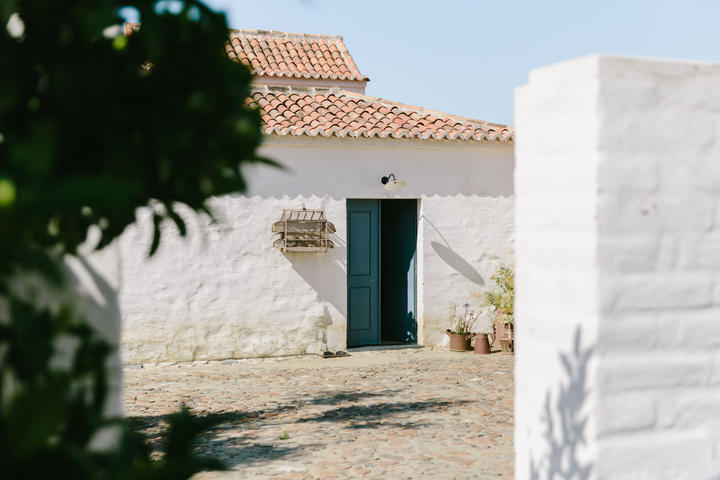
Arriving at this rejuvenated farm retreat brings with it a
feeling of homecoming. A golf buggy swiftly collects our bags and
we teeter close behind, walking along the cobbles at a leisurely
pace. We are guided to the southern buildings, traditionally used
to house animals and strategically positioned downwind of the
northern buildings, formerly the farmer’s lodgings. Inhabited since
Neolithic times by sedentary tribes, São Lourenço do Barrocal was
once the epicentre of the prehistoric culture of central Alentejo.
In the 19th century it grew to become a thriving farming village
providing enough livestock, grain, vegetables and wine to sustain
up to 50 resident families year-round. With its own chapel,
schoolroom and bullring, it was not only a centre for farming and
trade but also a tight-knit community.
As 6pm approaches we make our way to the vegetable garden where
we meet our chef for the evening and begin to forage for our
dinner. Here the seasons rule above all else and we learn about the
garden’s strict planting calendar while wandering through raised
beds of organic crops. Beetroots are cut at the root and lettuce at
the tusk before being placed in the chef’s weighty wicker basket.
By now cows have gathered at the perimeter of the vegetable garden
– as I’m told they do most evenings – casting judgemental glances
over our hoard.
Doubling back to one of the farm-view cottages we unpack our
basket and set to work on dinner. We start by preparing a simple
cod and chickpea dish followed by a medley of fava beans with
regional sausages and fresh strawberries. There’s a rhythm in
shelling the fava beans – as an inexperienced yet eager sous-chef I
peel far too many pods. The extras are cast aside and a smashed
clove of garlic is fired into the pan, quickly echoed by olive oil
and a dash of salt. The rural fare is simple – honey, vinegar, oil
and herbs are the staples of most dishes.
Dinner is served on the back porch of the house on a picnic
table flanked with thick mantas Alentejanas (local woollen rugs).
Wine tasting on the cottage’s terrace sees us sample a range of
house-fortified wines – the hotel’s manager, Ana Faustino, explains
that the winery is an integral part of the hotel and the estate’s
regeneration. “More than a century ago, São Lourenço do Barrocal’s
founder helped to foster the region’s reputation for winemaking,
planting many thousands of vines after recognising the area’s
outstanding terroir.” Handpicked grapes form the basis of
limited-edition bottles foraged from ten-year-old vines, which are
sold at the hotel and selected shops. A dessert plate evaporates
over the course of an hour – first from the heat and then via our
nibbling forks.
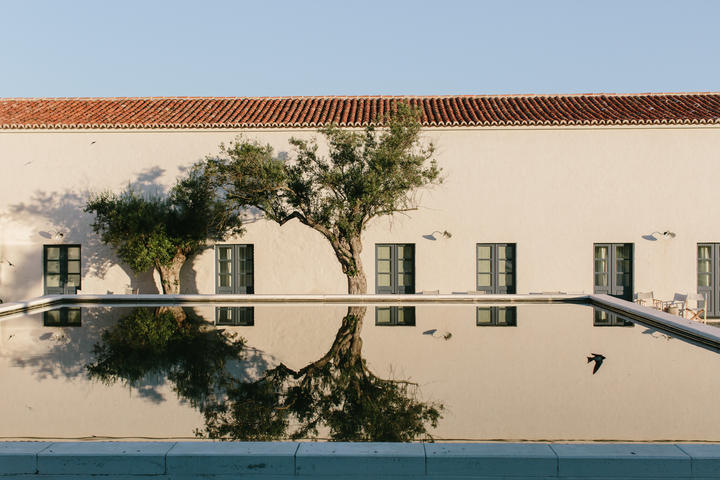
Returning to our rooms on a lukewarm summer evening, moonlight
floods the cobbled courtyard. Celestial bodies accompany me on my
short walk back through the hushed monte. Reaching my room, I turn
the lock twice and step inside. From my window I can still see the
moon beaming through its own circumference, its dog-eared outline
marking the day’s end.
My alarm is set for 8am but I pre-empt its call. Walking out
into the morning I feel like the sole resident of the estate.
Hearing hushed chatter and a baritone hum from the kitchen brings a
great sense of comfort and of work. The dulcet tones of
chattering
French girls louden on my approach to the restaurant, where a
large kitchen table bellows with a generous spread of meats,
cheeses, breads and fruits. A whole honeycomb teeters on the
corner. I sample the rosette ham and orange slices dusted with
cinnamon and finished with a sugary crunch before ordering coffee
and sitting for a while at the outdoor picnic tables that are
dappled with light from breaks in the trellis overhead.
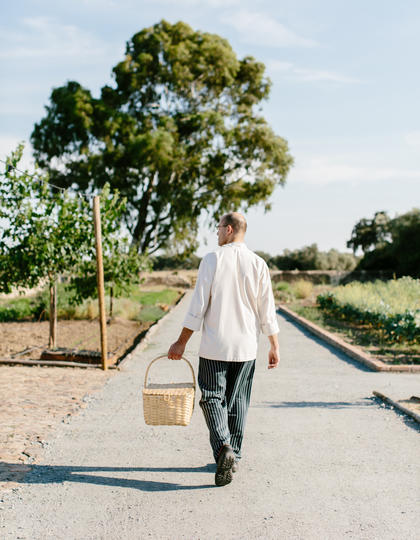
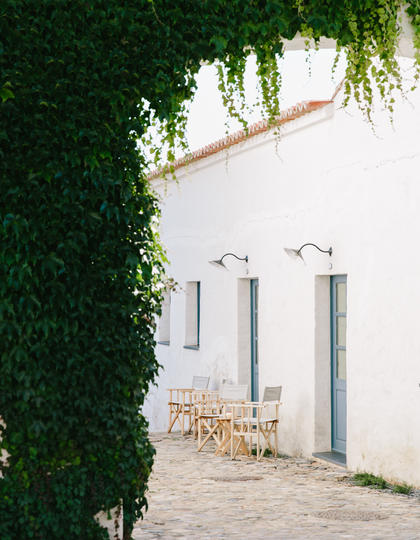
Our plan for the afternoon is to go by horseback to Monsaraz,
the castle town in the high hills. I am armed with some key
Portuguese words: lento, confiável and cavalo (slow, reliable and
horse) in preparation for riding one of the estate’s Lusitano
thoroughbreds, the oldest saddle horses in the world. However this
plan is quickly subverted in favour of a carriage ride due to the
challenging terrain and our incompetence. Taking a less- trodden
path we head out into the estate with Pedro, the head horseman.
About 30 minutes into our ride we pass throughways of wheat fields,
thistles and wild flowers, which lead to a river with untamed
horses visible in the distant corner of my eye.
We pass a lake where cattle graze amid the large barrocais that
defy gravity in the centre. “Pare,” asserts Pedro – an instruction
for both the horse and for us. We stop, unpack our picnic and
settle under the shade of an oak tree as endless brown packages
appear from two small wicker baskets – veal and mushroom
sandwiches, fluffy quiche, partridge escabeche, fresh strawberries.
This, we realise, is what is meant by a “leisurely lunch”. After
feasting we spread out on woven rugs and rest for a while. A long,
loud bleating rouses us from our snoozing – Pedro and his steed
have returned. On our way back through the estate’s peripheries the
scenery changes from flaxen to hues of olive green with flickers of
mauve from bulbous thistle heads.
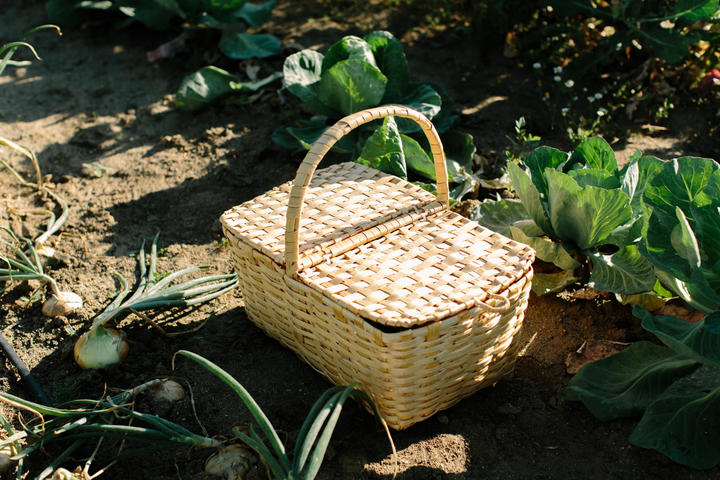
On returning to the estate I make an immediate advance for the
Susanne Kaufmann Spa Barrocal, identifiable only by an enamelled
sign and a small vase of lavender on the corner step. Inside there
is something quite monastic about the surrounds. I am guided to a
private treatment room and gestured to the massage table. A spritz
of lavender washes over my face as the therapist presses down on my
sternum, then flexes my feet. An hour passes. A citrus fragrance
wafts past my nostrils and with that the massage ends.
Later that evening the tinkering of silverware precedes our
entering the hotel’s farm-to-table
restaurant, Alentejo. It has a refined, rustic look, with
stripped-wood tables and a timber-clad bar. On the far side of the
room a series of custom-made shelves displaying objects found when
the building was first cleared out offer hints to the family’s
make-up, a sort of generational history told through heirlooms – a
miniature chair, a shoe, a cushion loaded with hat pins, hedge
clippers and, just left of the centre, a small red vocabulary book
opened at page 294/5 with “familia” circled in biro.
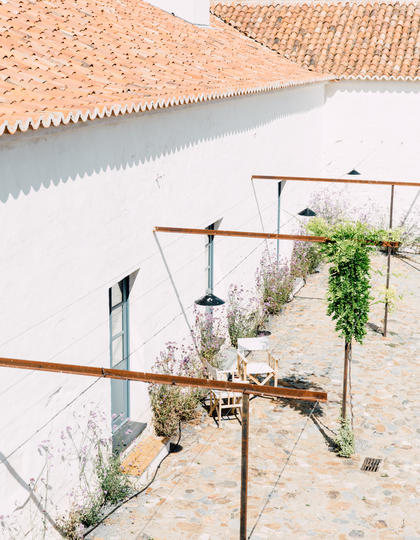
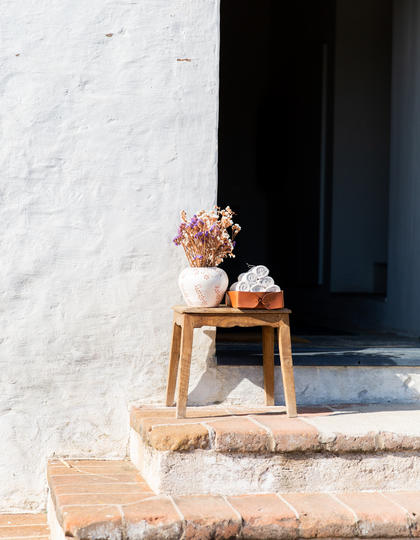
Deeply rooted in Alentejo’s traditions, the food is focused
around time-honoured dishes. Tradition and authenticity are at the
root of everything here. Hand-thrown tea lights radiate flecked
light across the tables as we order sautéed vegetables with
green-pea purée, poached egg, tuna ceviche with avocado and
passionfruit, and a cheese pudding with homemade pumpkin jam.
Digesting our meal, and the day’s activities, I start to get a real
feel for the hotel, the land and the family’s relationship with
both.
I ask José for his response when people ask him to describe this
place and am met with a long pause. “I don’t know how to translate
it other than to say it is our shared experience of this place and
how we can live in today’s age. It’s not melancholy, neither is it
nostalgia – it’s just shared.” Sharing in this place for only a few
short days, I feel both melancholia and nostalgia for it even
now.
Doubles at São Lourenço do Barrocal cost from £150 a night
including breakfast
Join the Mr & Mrs Smith travel club to enjoy a best-price
guarantee, as well as a little something extra on arrival
mrandmrssmith.com / +44 330 100 3180
